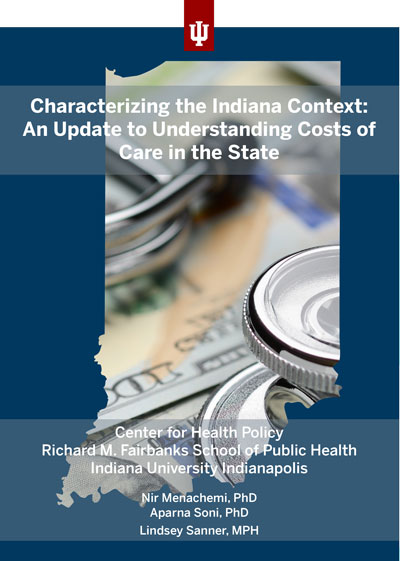A new report from the IU Richard M. Fairbanks School of Public Health outlines the most recent publicly available data on a wide range of factors impacting health care costs and outcomes in Indiana, including spending by industry, market characteristics, and Hoosiers’ health conditions.
The report was commissioned by the Indiana Business Health Collaborative (IBHC), a statewide coalition of employers, economic development organizations, health care industry stakeholders, and more working to develop comprehensive solutions to address cost, access, and quality of care in Indiana.
The report compares approximately 80 health measures for Indiana, the U.S., and four of Indiana’s neighboring states, assessing trends over time in each metric since the school’s initial report in 2020.
IBHC Chief Executive Luke Messer says the Collaborative pursued the report to shed light on the state’s current landscape and provide an actionable framework for IBHC members to consider as they work together to improve health care in Indiana.
“While Indiana benefits from a strong economy, improving the health status of Hoosiers and lowering overall health care costs is essential for further economic prosperity,” said Messer. “This report is an important step in identifying our state-specific challenges and how we can address them.”
According to the report, Indiana’s total per-capita health care spending, including spending for hospital care, physician services, and pharmaceuticals, is nearly identical to the national average and in-line with neighboring states. On average, Hoosiers spend 10.7% of their median income on health care, which ranks below the national average and decreased 7% since 2020.
Competition among insurance companies in the state is consistent with U.S. norms while the Indianapolis hospital market is slightly more competitive than the national average.
Indiana differs from other states in its high prevalence of self-insured health plans, the report found. Sixty-six percent of Indiana’s private sector employees are enrolled in self-insured plans, which ranks 20% higher than the national average.
“Over the past few years, self-insurance has grown in Indiana, even while it has declined in the U.S. and each of our neighboring states,” said Dr. Nir Menachemi, dean of the Fairbanks School of Public Health and co-author of the report. “Self-insured employers lack the market power to effectively negotiate prices, and studies show that self-insured plans pay higher prices for the same services. Addressing this market dynamic may result in lower prices.”
High-deductible health plans (HDHPs) are also dominant in Indiana. According to the report, nearly 64% of Hoosier employees are enrolled in HDHPs, which increased 23% since 2020 and ranks higher than the national average.
“The prevalence of high-deductible health plans may partially explain patients’ higher out-of-pocket costs in Indiana, despite our overall average ranking in health care spending,” said Menachemi.
Fairbanks researchers also note that Indiana has a greater shortage of physicians, both in general practice and specialty care, than the rest of the nation, in addition to lower utilization of value-based care payment models.
“Moving toward greater use of value-based payment models, including bundled payments and accountable care in settings where the evidence supports them, may contribute to more cost-effective, patient-centered health care,” said Menachemi.
Meanwhile, Indiana continues to perform worse than the national average in most health outcomes, which have declined over time. Indiana’s mortality rate is nearly 16% higher than the national average, led by an 81% increase in drug deaths since 2020. In addition, the state has higher rates of nearly all chronic diseases, including cardiovascular disease, diabetes, and obesity. Since 2020, cardiovascular disease prevalence increased 30% in Indiana, while the prevalence of diabetes and childhood obesity rose 27% and 24%, respectively.
While still higher than the national average, maternal mortality declined 38% and infant mortality declined 2% in Indiana since 2020. Authors attribute the improvement to the state’s concerted efforts to expand funding for maternal health coverage and programming. Further, authors note that the state’s recent $225 million public health investment, a 1,500% increase in statewide funding, is projected to significantly improve overall health outcomes.
Since 2020, state policymakers have passed several laws to reduce health care costs in Indiana, including enacting hospital price transparency requirements, encouraging competition in the health care industry, implementing the state’s All Payer Claims Database for consumers to compare health care prices, and installing guardrails around previously unregulated market participants such as pharmacy benefit managers.
“We commend our state policymakers for their efforts to curb health care spending in Indiana,” said Messer. “The IBHC is dedicated to building on those efforts, and the findings of this report will help guide our work to further improve health care affordability, access, and outcomes across the state.”


